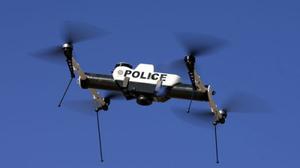UAVsAs domestic use of drones grows, privacy advocates worry
Small aerial drones are moving from the battlefield to local communities, and the pace grows faster; during the next year, drones may be used in cities and towns to help fight crime and keep officers out of danger; their use would save on the cost of fuel for police helicopters; some would feel safer as a result, but activists worry that this could be the beginning of a systemic invasion of privacy

One of many drone configurations coming into use by police // Source: ganjejang.com
Small aerial drones are moving from the battlefield to local communities, and the pace grows faster. During the next year, drones may be used in cities and towns to help fight crime and keep officers out of danger. Their use would save on the cost of fuel for police helicopters. Some would feel safer as a result, but the San Francisco Chronicle reports that activists worry that this could be the beginning of a systemic invasion of privacy. Civil rights groups argue that the drones could lead to unwarranted surveillance of citizens, and last Thursday these groups made their opinions known as they gathered outside Oakland City Hall to oppose the Alameda County Sheriff’s plan to purchase drones. If the department did, it would be one of the first local law enforcement agencies in the country to do so.
Sergeant J. D. Nelson, a spokesman for the sheriff, told the public that the drones would be used in the same capacity that helicopters are used today.
The Chronicle notes that the main reason behind the purchase of the drones is money. Fueling a $3 million helicopter can get expensive, but sending out a battery-powered drone that costs between $50,000 and $100,000 can free up money for other programs or more officers to work patrols.
A 4-pound model which was tested by deputies was loaded with high definition cameras and was able to stay in the air for several hours before needing a recharge.
Despite the positive news, Sheriff Gregory Ahern drew the ire of privacy advocates and civil rights groups last week when he said he would use the drones to search for marijuana farms and called such projects “proactive policing.”
“It will become integrated into their everyday police tactics,” Rachel Herzing, an activist with Critical Resistance, told the Chronicle. “A few years ago, we didn’t see tanks or armored vehicles in the streets of Oakland. Now we see it and it’s become almost normal.”
The use of drones for domestic missions has risen significantly. Fire crews use drones to get a better look at wildfires they cannot get to with helicopters, environmentalists use drones to monitor the patterns of movement in animals, and scientists are in the process of using drones to get aerial views of hurricanes and tornados.
There are few law enforcement agencies using drones at this time, but a rise in federal grant money, the cheaper price tag for drones, and the advanced technology they offer will increase their use in the future. This increase use could also lead to more legal battles, and Jim Dempsey, the vice president for public policy at San Francisco’s Center for Democracy and Technology, agrees.
According to Dempsey, the U.S. Supreme Court has ruled that what is viewable from the air is fair game for police, but if a drone were to tail a suspect for an extended period of time, a search warrant may be needed by police. Dempsey told the Chronicle that drone technology was outpacing the law books, and that “this issue is headed straight for the Supreme Court.”
Trevor Till, a spokesman with the Electronic Frontier Foundation, wants local police to collaborate with privacy advocates to draft a set of regulations, instead of wasting time fighting it out in the courts.
“We want to make sure there are robust rules in place before they fill up the skies of the Bay Area,” Timm told the Chronicle. “Right now, it’s cheap, it’s easy, and there’s no rules of the road. It could get out of control very fast.”
